Long exposure photography with your smartphone can create stunning, ethereal images, but you'll need a steady hand—or better yet, a tripod. Essential for eliminating camera shake, tripods allow you to experiment with slow shutter speeds, turning ordinary scenes into magical landscapes. You'll find options ranging from lightweight plastic models to sturdy full-size tripods, each offering unique benefits for mobile photographers. Consider factors like portability, stability, and compatibility when choosing. Don't forget to explore alternative stabilization methods like flexible tripods or smartphone clamps for versatility. With the right support, you'll reveal a world of creative possibilities in your mobile photography arsenal.
Understanding Long Exposure Photography
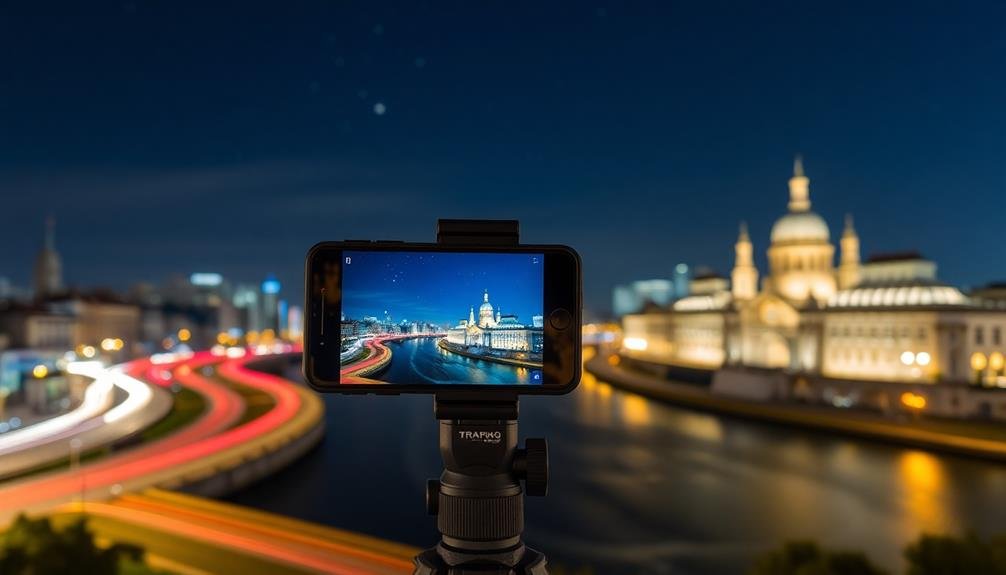
Long exposure photography is a mesmerizing technique that can transform ordinary scenes into stunning, ethereal images. It involves using slow shutter speeds to capture motion blur or light trails, creating a sense of movement in still photographs. You'll need to keep your camera steady for extended periods, typically from a few seconds to several minutes.
To achieve this effect, you'll adjust your camera's settings. Start by switching to manual mode and setting a low ISO to reduce noise. Choose a small aperture (high f-number) to increase depth of field and lengthen exposure time. Then, select a slow shutter speed based on the effect you're after. For smooth water or cloud movement, try 1-30 seconds. For light trails or star trails, experiment with exposures lasting several minutes.
You'll also need to take into account lighting conditions. Long exposures work best in low light situations like twilight or night. During the day, you may need to use neutral density filters to reduce light entering the lens, allowing for longer exposures without overexposure.
Benefits of Tripods for Smartphones
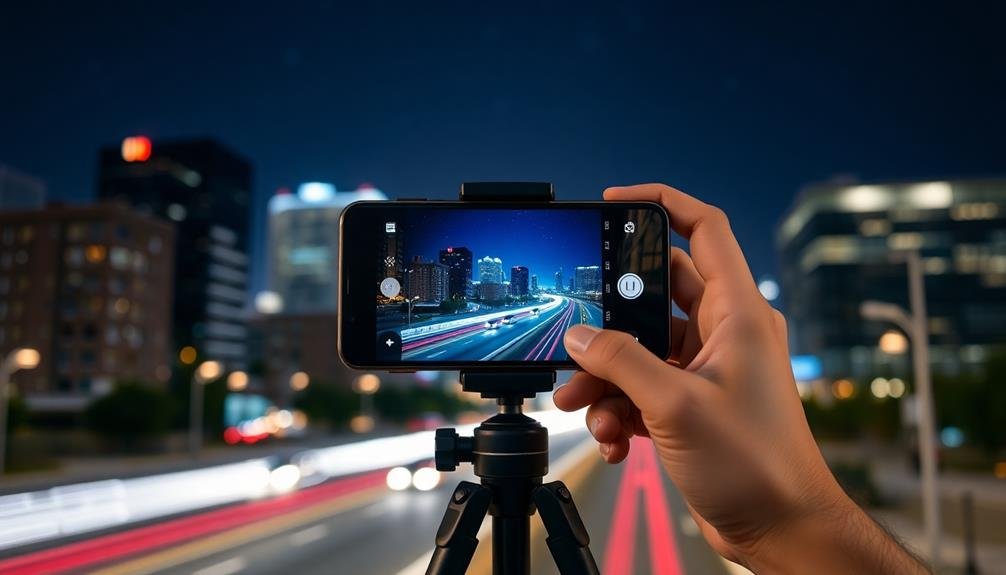
Stability is the cornerstone of great smartphone photography, and tripods offer a wealth of benefits for mobile shooters. By eliminating camera shake, tripods allow you to capture sharp images in low-light conditions and explore creative techniques like long exposures. You'll notice a significant improvement in image quality, especially when shooting at slower shutter speeds or higher ISO settings.
Tripods also enable you to experiment with composition more freely. You can take your time framing shots, adjust settings without worrying about movement, and even use the timer or remote shutter to include yourself in group photos.
For video creators, a tripod is essential for smooth panning shots and stable footage. Moreover, tripods open up possibilities for time-lapse photography and astrophotography, letting you capture stunning sequences of cityscapes or starry nights.
They're particularly useful for HDR photography, ensuring perfect alignment between multiple exposures. You'll also find that using a tripod encourages you to slow down and think more critically about your compositions, ultimately improving your photographic skills.
With a tripod, you can push your smartphone's camera to its limits and achieve results that rival those of dedicated cameras.
Top Smartphone Tripods for Stability
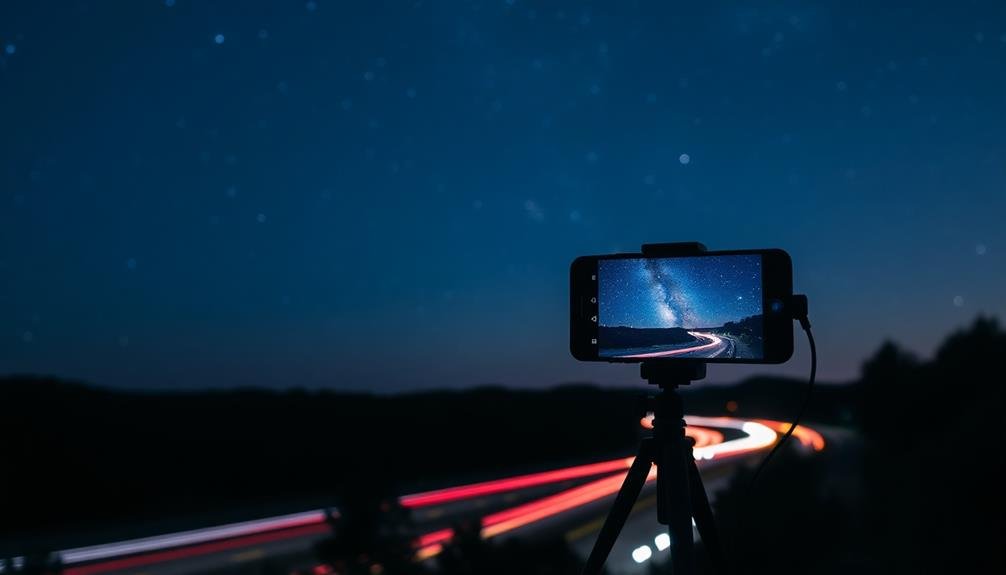
When choosing a smartphone tripod for stability, you'll encounter both compact and full-size options.
You'll need to weigh the portability of smaller tripods against the enhanced stability of larger models.
Consider the tripod's material and weight, as these factors affect both its durability and ease of transport.
Compact vs. Full-size Options
Choosing between compact and full-size tripods for your smartphone can be a game-changer for your mobile photography.
Compact tripods offer portability and convenience, easily fitting in your pocket or bag. They're ideal for spontaneous shoots and travel photography. These mini tripods often feature flexible legs that can wrap around objects, giving you creative mounting options. However, their small size limits height adjustability and stability in windy conditions.
Full-size tripods, on the other hand, provide maximum stability and versatility. They offer greater height options, allowing you to shoot from various angles and perspectives. You'll find them particularly useful for landscape photography, long exposures, and low-light situations. Many full-size tripods come with smartphone adapters, making them compatible with your mobile device.
The trade-off is their bulkier size and weight, which can be cumbersome for on-the-go shooting.
When deciding between compact and full-size options, consider your shooting style, preferred locations, and how much gear you're willing to carry. If you prioritize portability, go for a compact tripod. For maximum stability and versatility, opt for a full-size model.
Some photographers even keep both types in their kit for different scenarios.
Material and Weight Considerations
How do material and weight affect your smartphone tripod's performance? These factors play a significant role in determining the stability, portability, and durability of your tripod.
Aluminum is a popular choice for its lightweight nature and affordability, making it ideal for on-the-go photographers. However, it may not be as sturdy as other materials in windy conditions.
Carbon fiber, while pricier, offers an excellent balance of strength and weight, providing superior stability without adding bulk to your kit.
When considering weight, remember that heavier tripods generally offer more stability, especially for long exposure shots. But they're less convenient to carry around.
Lightweight options are great for travel but may require additional stabilization techniques in challenging environments. Some tripods come with a hook at the bottom of the center column, allowing you to hang a weight for added stability.
Don't forget to factor in your smartphone's weight and any additional accessories you'll be using. A tripod that's too light might struggle to support a hefty phone case or external lenses.
Ultimately, choose a material and weight that best suits your shooting style and mobility needs.
Choosing the Right Tripod Material
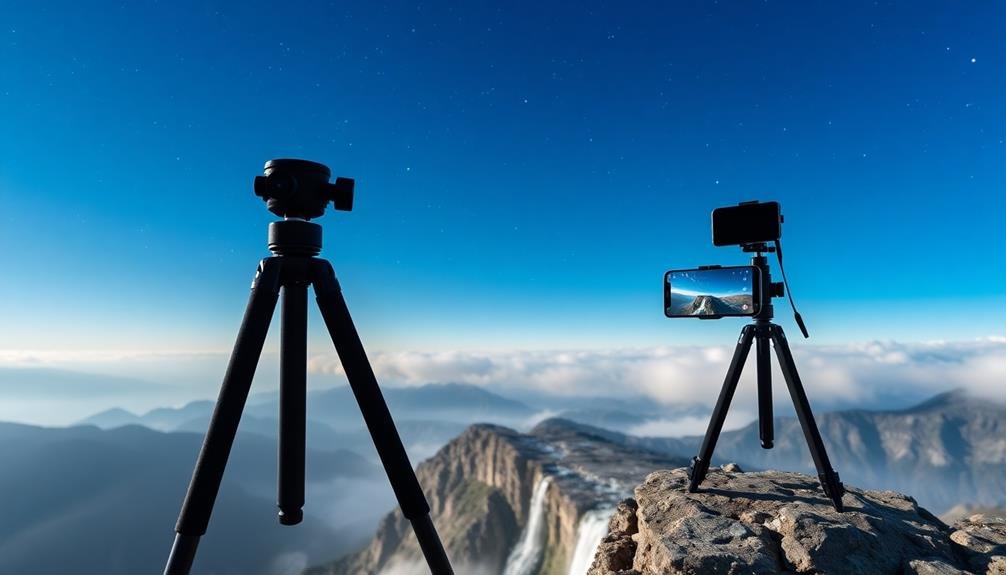
When selecting a tripod for your smartphone, you'll need to evaluate the material it's made from.
Aluminum and carbon fiber are popular choices for their durability and strength, with carbon fiber being lighter but more expensive.
If you're on a tight budget, plastic tripods offer a more affordable option, though they may sacrifice some stability and longevity.
Aluminum vs. Carbon Fiber
In light of the various tripod materials available, aluminum and carbon fiber stand out as the top contenders for mobile photographers. When choosing between these two, you'll need to take into account their unique characteristics and how they align with your needs.
Aluminum tripods are known for their durability and affordability. They're heavier than carbon fiber, which can be an advantage in windy conditions. However, this extra weight might be a drawback if you're planning long hikes or frequent travel.
Aluminum also conducts temperature, so it can feel cold in winter and hot in summer.
Carbon fiber tripods, on the other hand, are considerably lighter and don't conduct temperature. They're ideal for photographers who prioritize portability and comfort.
Carbon fiber is also more resistant to vibrations, which can be essential for long exposure shots. The downside? They're typically more expensive than their aluminum counterparts.
Evaluate your budget, shooting style, and mobility requirements when making your choice. If you're often on the move or shooting in challenging conditions, carbon fiber might be worth the investment.
For occasional use or budget-conscious photographers, an aluminum tripod could be the perfect fit.
Plastic Tripods: Budget Options
While aluminum and carbon fiber tripods dominate the market, plastic tripods shouldn't be overlooked as budget-friendly options for mobile photographers. These lightweight and affordable alternatives can be surprisingly versatile for casual shooters or beginners.
Plastic tripods often feature composite materials that offer decent stability for smaller devices like smartphones or compact cameras.
When considering a plastic tripod, you'll want to keep a few key factors in mind:
- Weight capacity: Make sure it can support your mobile device and any additional accessories
- Folded length: Look for compact options that are easy to carry
- Leg locks: Check for secure and user-friendly locking mechanisms
While plastic tripods may not match the durability of their metal counterparts, they can be an excellent starting point for those new to mobile photography.
They're also ideal for travel, as their lightweight nature won't weigh down your bag. However, be aware that plastic tripods may not perform as well in windy conditions or with heavier camera setups.
For basic mobile photography needs, though, a well-made plastic tripod can provide the stability you need without breaking the bank.
Compact vs. Full-Size Tripod Options
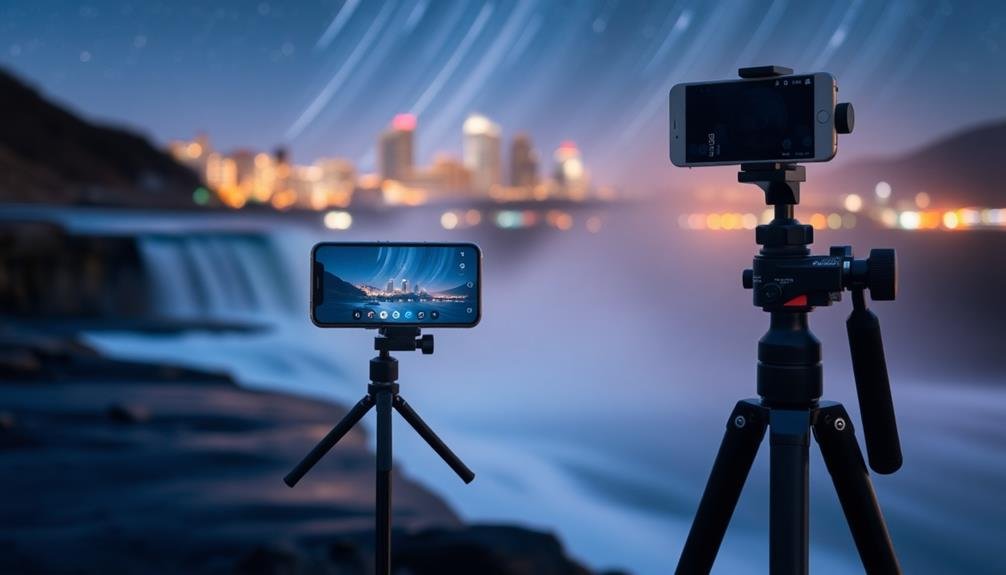
Weighing the pros and cons, mobile photographers often find themselves torn between compact and full-size tripod options.
Compact tripods offer portability and convenience, fitting easily into your bag or pocket. They're ideal for spontaneous shoots and travel photography. However, their small size can limit stability and height adjustments, potentially compromising your shot composition.
Full-size tripods, on the other hand, provide superior stability and versatility. They offer greater height range, allowing you to capture shots from various angles. Their robust build can withstand heavier equipment and challenging weather conditions.
The downside? They're bulkier and less convenient to carry around.
When choosing between compact and full-size options, consider your shooting style and priorities. If you're always on the go and value convenience, a compact tripod might be your best bet. But if you prioritize image quality and versatility, a full-size tripod could be worth the extra weight.
Some photographers opt for both, using a compact tripod for casual outings and a full-size one for planned shoots.
Ultimately, your choice should align with your specific needs and photography goals.
Alternative Stabilization Methods for Smartphones
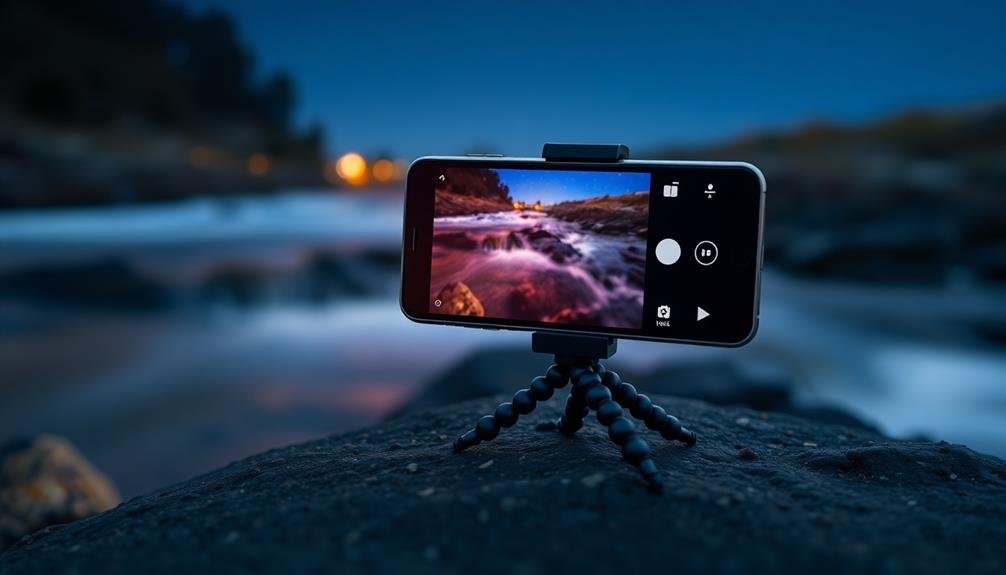
Several alternative stabilization methods exist for smartphone photographers who don't want to carry a traditional tripod. You can use everyday objects or specialized accessories to keep your phone steady for long exposure shots or low-light photography.
One popular option is a small, flexible tripod with bendable legs. These compact devices can wrap around poles, branches, or uneven surfaces, giving you stability in various environments.
Another alternative is a smartphone clamp with a built-in stand. These lightweight accessories easily fit in your pocket and provide a quick setup for impromptu shots.
For handheld stability, consider using:
- A gimbal stabilizer for smooth video and panning shots
- A phone grip with finger loops for better control
- A lanyard or wrist strap to prevent accidental drops
You can also improvise with objects around you. Rest your phone against a wall, on a table, or atop a stack of books. Use a bag of rice or beans as a makeshift beanbag support.
When outdoors, lean against a tree or place your phone on a flat rock for added stability. With these alternatives, you'll always have a way to capture steady shots, even without a traditional tripod.
Long Exposure Techniques With Tripods
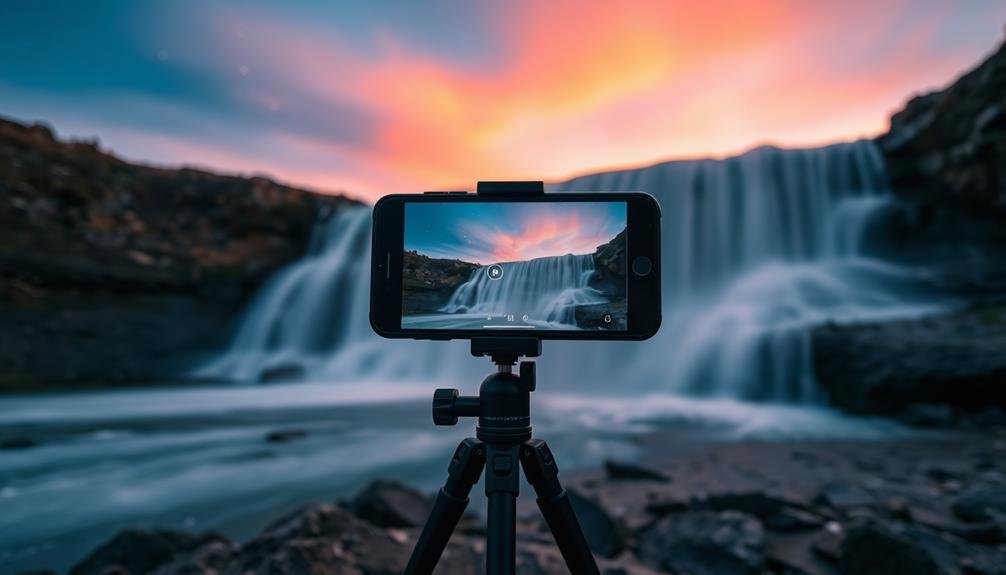
Long exposure photography opens up a world of creative possibilities when you pair your smartphone with a sturdy tripod. You'll be able to capture stunning light trails, silky smooth waterfalls, and star trails with ease. To get started, you'll need a smartphone camera app that allows manual control of shutter speed. Set your phone on the tripod, adjust your composition, and experiment with different exposure times.
For best results, use these techniques:
- Enable your phone's timer or use a remote shutter to avoid camera shake.
- Lock your focus and exposure before starting the long exposure.
- Use a neutral density filter for daytime long exposures.
- Experiment with light painting using flashlights or glow sticks.
Here's a quick guide to common long exposure subjects and recommended shutter speeds:
| Subject | Shutter Speed | Effect |
|---|---|---|
| Traffic | 5-30 seconds | Light trails |
| Waterfalls | 1-5 seconds | Silky water |
| Fireworks | 2-10 seconds | Light bursts |
| Star trails | 30+ minutes | Circular star paths |
| Light painting | 10-30 seconds | Custom light designs |
Remember to keep your phone charged, as long exposures can drain battery quickly. With practice, you'll master these techniques and create stunning images.
Frequently Asked Questions
Can I Use a Regular Camera Tripod for My Smartphone?
Yes, you can use a regular camera tripod for your smartphone. You'll just need a smartphone adapter or mount to attach your device securely. This setup allows you to stabilize your phone for better shots, especially in low-light conditions.
How Do I Attach My Smartphone Securely to a Tripod?
You'll need a smartphone tripod adapter. It's a clamp-like device that securely holds your phone. Simply attach it to your tripod's mounting plate, insert your phone, and tighten the grip. It's quick and easy to use.
Are There Waterproof Tripods for Underwater Long Exposure Photography?
Yes, you'll find waterproof tripods for underwater long exposure photography. They're made of corrosion-resistant materials like aluminum or carbon fiber. You can use them in shallow water or with special housings for deeper dives. Always check depth ratings before use.
What Apps Are Best for Long Exposure Photography on Smartphones?
You'll find several great apps for long exposure smartphone photography. Try Slow Shutter Cam, ProCam, or NightCap Camera for iOS. Android users can check out Camera FV-5 or LongExpo. These apps offer manual controls and specialized modes.
How Do I Prevent Camera Shake When Pressing the Shutter Button?
To prevent camera shake, you can use a self-timer or remote shutter release. Alternatively, try gently tapping the screen or using volume buttons. Steady your hands by bracing against a solid surface or using a tripod.
In Summary
You're now equipped to elevate your mobile photography with long exposure techniques. Remember, a sturdy tripod is your best friend for capturing stunning low-light scenes and silky-smooth water effects. Whether you opt for a compact or full-size model, choose one that suits your needs and budget. Don't forget to experiment with alternative stabilization methods too. With practice and the right gear, you'll be creating magical long exposure shots in no time.

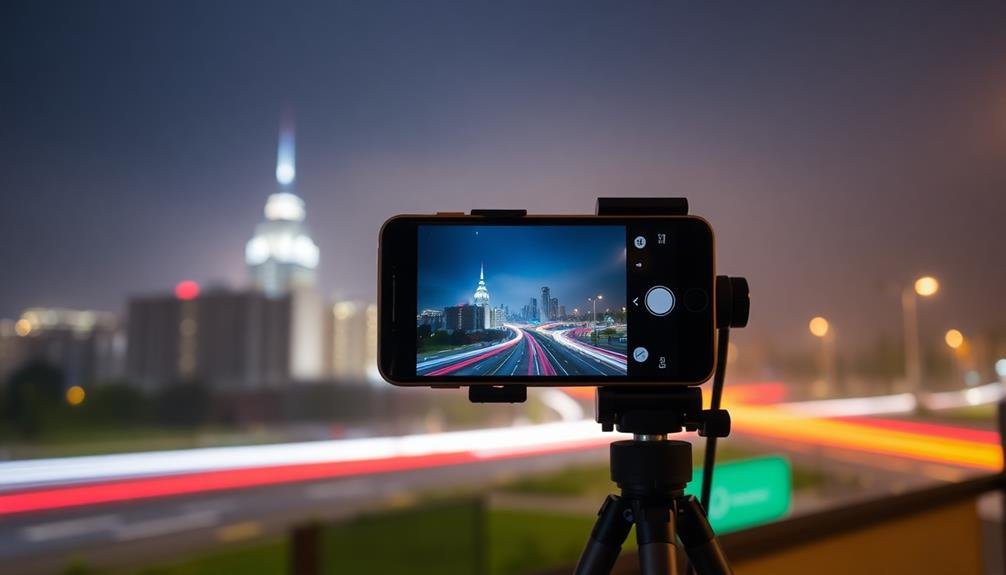



Leave a Reply